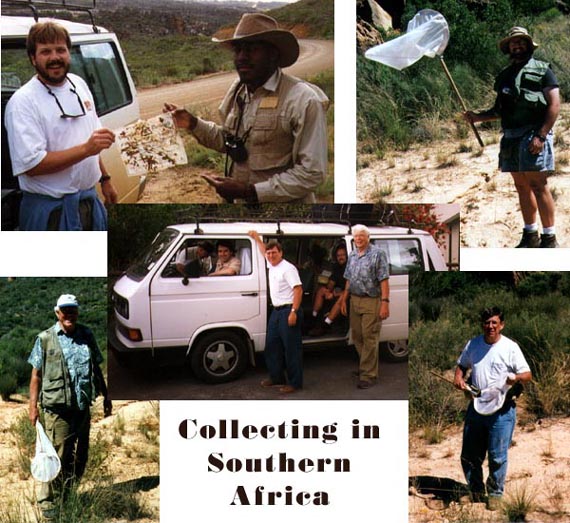
1996 Schlinger Expedition to the Republic of South Africa & Namibia
The Fall 1996 Schlinger Expedition (Oct. 27 to Dec. 5) to the Republic of South Africa and Namibia, organized by Mike Irwin, sampled the insect fauna from Pietermaritzberg to Capetown to the Kalahari, with all the members of the expedition present as the expedition moved into the Clanwilliam area (Nov. 11 to Nov. 18). These participants included Evert Schlinger, Mike Irwin, David Yeates, Brian Wiegmann, Don Webb, Steve Gaimari, Mark Metz, and Kevin Holston. Mike and Ev arrived in South Africa first and collected in Natal, traveling through the Mkuzi game reserve area, Ndumu, and the Drakensberg mountains. Mike and Ev also left Africa last; with David, they continued north from Clanwilliam to collect in the Namib and Kalahari deserts as the other members of the expedition prepared for their return to the United States. In the Clanwilliam area, we collected along the southwest coast to inland karoo, consisting of heath and scrub vegetation with low shrubs and succulents, searching for elusive therevids.
We collected specimens of several therevid genera including Neotabuda,Orthactia, Phycus, and Rupellia; most of the material has not yet been curated or determined to genus, and it likely includes several undescribed species. Type specimens will be deposited in the Natal Museum (South African species) and the Namibian National Insect Collection, National Museum of Namibia (Namibian species). We collected most of the therevids and other insects by using a diversity of malaise traps, which differed in size and in structural design. We also netted specimens as they were spotted or by sweeping the vegetation, and we sieved larval therevids from the sand. Specimens for molecular studies, to be conducted in Brian Wiegmann’s lab, were collected and placed into 100% ethanol. We sorted through the malaise trap samples each night and pinned the therevids and many other insects (mostly flies!). The rest were layered with soft material for later curation.
As might be expected by the number of dipterists on this expedition, many interesting flies were collected, as well as other distinctive members of the South African insect fauna. We collected asilids, bombyliids, chamaemyiids, empids, nemestrinids, syrphids, and vermileonids, to name a few dipteran families. Larvae of Heterotropus, a genus of flies currently placed in Bombyliidae but with an unclear relationship to other asiloid genera, were collected as we sifted for therevid larvae. Adults were also taken. We also encountered huge wingless tettigoniids (Orthoptera); buprestids (Coleoptera) with outlandish, colorful tufts of hair; spindle-winged nemopterids (Neuroptera); and a wide array of sphecids (Hymenoptera).
Our interactions with the arthropod fauna were usually short and to the point, but our interactions with other members of the South African fauna were varied and usually not as confrontational. Included among the birds we saw in South Africa are bee-eaters, weaverbirds, the blue crane, and the ubiquitous Cape francolin and pied crow. On one occasion, a large, black cobra raised up and spread its hood in protest against the approach of our vehicles, but retreated into the roadside grass before we could attempt to reconcile our differences. We caught glimpses of mongooses and hyrax, watched eland, Thompson’s gazelles, kudu, and other antelopes, and had the opportunity to acquaint ourselves with the Chacma baboon. A troop of about thirty baboons in the Cedarberg Mountains decided that Brian was collecting where he should not have been: in their territory. Those of us who saw the look on Brian’s face as he leapt out of the bushes onto the road are still not sure if all the barks and screams we heard were only from the baboons.
Notwithstanding such entertaining interludes, this expedition has increased our understanding of the family Therevidae. The South African material will play a critical role in determining the worldwide distribution and evolutionary relationships among the lineages within this family.
The Fall 1996 Schlinger Expedition received invaluable assistance in Pietermaritzberg from Michael J. Samways and Ray M. Miller of the University of Natal, and David Barraclough, Brian Stuckenberg, and Jason Londt of the Natal Museum. In Capetown, we were fortunate to have Hamish Robertson of the South African Museum and Tim Maggs and Al Lastovica of the University of Capetown as our hosts. Support in Namibia was provided by Eugene Marais at the National Museum of Namibia, Windhoek, and Mary Seely of the Namib Desert Research Station, Gobabeb.